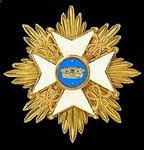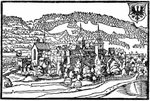First raised March 1713.
Chefs: 31st May 1741-1760 Colonel Moritz, Prince of Anhalt-Dessau, later Field Marshall; 22nd April 1760-1768 Major General Balthasar Rudolf von Schenckendorf, later Lieutenant General
The regiment was with the King's army that took the Saxon army at Pirna; the grenadiers were at Lobositz. As IR22 was involved in the siege of Prague it missed the battle but was hard hit at Kolin 18th June 1757. It was part of the right wing under Bevern which should have been held back or "refused" to act as a reserve but Bevern's force "was plagued by misunderstandings which led to five of its battalions being led into an attack on the Prezerowsky Hill" (Duffy,
By Force Of Arms). Although the decisive action of the battle was on the left wing, IR22 and its companion regiments suffered very heavy casualties in the final phase of the battle. IR22 lost 26 officers and 1165 men, four-fifths of its manpower. The grenadiers fought at Rossbach and Leuthen. (
Duffy, Army of Frederick the Great, 1st Edition (henceforth Duffy AFG1) shows around 25% casualties for the grenadiers with IR17 at Leuthen.)
The prisoners taken at Kolin returned at the beginning of 1758 and IR22 joined the Pomeranian Corps that met up with the King on August 22nd that year. On 25th August the army met the Russians at Zorndorf; IR22 was with its grenadiers. The regiment was in Kanitz's wing and faced the Russian cavalry counterattack. Losses were heavy. (Duffy AFG1 shows around 25% casualties in both of IR22's musketeer battalions and 50& casualties in the grenadier battalion with IR17, which was in the advance guard.) The regiment was at the relief of Kolberg in October.
The grenadiers fought at Kay on July 23rd 1759 and the musketeer battalions took Frankfurt on the Oder under Wobersnow. The grenadiers fought at Kunersdorf on 12th August. losing about 30% casualties (Duffy AFG1). The regiment marched from Pomerania under Kleist to join the King at Fürstenwalde.
It was with the King again in 1760 at the unsuccessful siege of Dresden July 10th to 22nd. The grenadiers were demolished at Landeshut. At Torgau on November 3rd it was in reserve with the main army. It was later part of the renewed attack under Hülsen that broke through and joined up with Zieten's attack, and decided the battle in favour of the Prussians, just when the Austrians were congratulating themselves on a victory. The commanders of both musketeer battalions received the Pour-le-merite.
IR22 was with the King again in 1761-2. At Burkersdorf 21st July 1762 it was part of the attack under Neuwied at Ludwigsdorf which stormed the defences there and captured them. Four company commanders were awarded the Pour-le-merite.
Christopher Duffy,
Army of Frederick The Great, says of IR22: "Massacred at Kolin and suffered heavily at Zorndorf. On 5th January 1741 the regiment entered Breslau "in blue and red uniforms with straw coloured waistcoats... a splendid collection of men, with fine shining weapons that were a delight to see" (Steinberger)".
And this was the uniform in 1756 :























